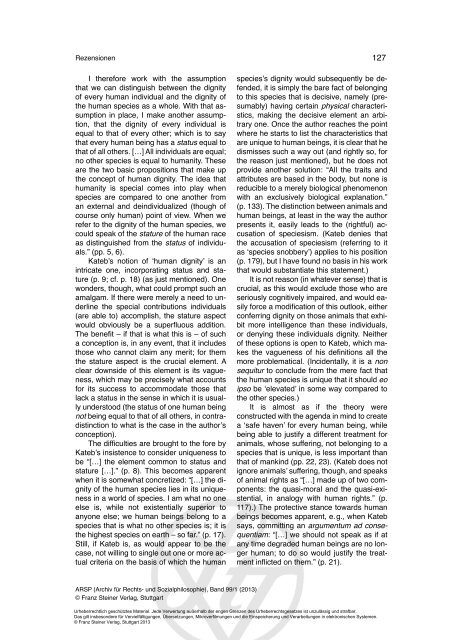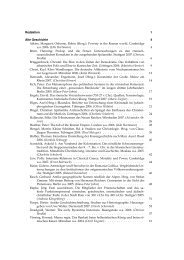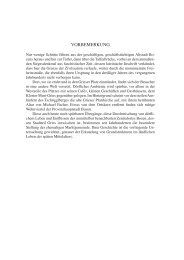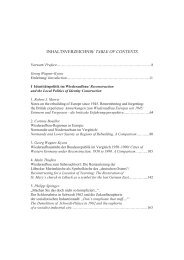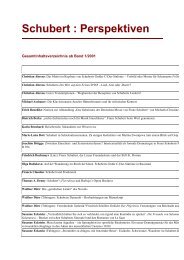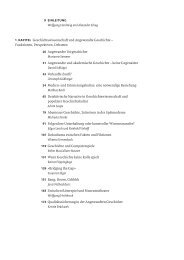Emmanuel Joseph Sieyès, Was ist der Dritte Stand? - Franz Steiner ...
Emmanuel Joseph Sieyès, Was ist der Dritte Stand? - Franz Steiner ...
Emmanuel Joseph Sieyès, Was ist der Dritte Stand? - Franz Steiner ...
Erfolgreiche ePaper selbst erstellen
Machen Sie aus Ihren PDF Publikationen ein blätterbares Flipbook mit unserer einzigartigen Google optimierten e-Paper Software.
Rezensionen<br />
I therefore work with the assumption<br />
that we can d<strong>ist</strong>inguish between the dignity<br />
of every human individual and the dignity of<br />
the human species as a whole. With that assumption<br />
in place, I make another assumption,<br />
that the dignity of every individual is<br />
equal to that of every other; which is to say<br />
that every human being has a status equal to<br />
that of all others. […] All individuals are equal;<br />
no other species is equal to humanity. These<br />
are the two basic propositions that make up<br />
the concept of human dignity. The idea that<br />
humanity is special comes into play when<br />
species are compared to one another from<br />
an external and deindividualized (though of<br />
course only human) point of view. When we<br />
refer to the dignity of the human species, we<br />
could speak of the stature of the human race<br />
as d<strong>ist</strong>inguished from the status of individuals.”<br />
(pp. 5, 6).<br />
Kateb’s notion of ‘human dignity’ is an<br />
intricate one, incorporating status and stature<br />
(p. 9; cf. p. 18) (as just mentioned). One<br />
won<strong>der</strong>s, though, what could prompt such an<br />
amalgam. If there were merely a need to un<strong>der</strong>line<br />
the special contributions individuals<br />
(are able to) accomplish, the stature aspect<br />
would obviously be a superfluous addition.<br />
The benefit – if that is what this is – of such<br />
a conception is, in any event, that it includes<br />
those who cannot claim any merit; for them<br />
the stature aspect is the crucial element. A<br />
clear downside of this element is its vagueness,<br />
which may be precisely what accounts<br />
for its success to accommodate those that<br />
lack a status in the sense in which it is usually<br />
un<strong>der</strong>stood (the status of one human being<br />
not being equal to that of all others, in contrad<strong>ist</strong>inction<br />
to what is the case in the author’s<br />
conception).<br />
The difficulties are brought to the fore by<br />
Kateb’s ins<strong>ist</strong>ence to consi<strong>der</strong> uniqueness to<br />
be “[…] the element common to status and<br />
stature […].” (p. 8). This becomes apparent<br />
when it is somewhat concretized: “[…] the dignity<br />
of the human species lies in its uniqueness<br />
in a world of species. I am what no one<br />
else is, while not ex<strong>ist</strong>entially superior to<br />
anyone else; we human beings belong to a<br />
species that is what no other species is; it is<br />
the highest species on earth – so far.” (p. 17).<br />
Still, if Kateb is, as would appear to be the<br />
case, not willing to single out one or more actual<br />
criteria on the basis of which the human<br />
127<br />
species’s dignity would subsequently be defended,<br />
it is simply the bare fact of belonging<br />
to this species that is decisive, namely (presumably)<br />
having certain physical character<strong>ist</strong>ics,<br />
making the decisive element an arbitrary<br />
one. Once the author reaches the point<br />
where he starts to l<strong>ist</strong> the character<strong>ist</strong>ics that<br />
are unique to human beings, it is clear that he<br />
dismisses such a way out (and rightly so, for<br />
the reason just mentioned), but he does not<br />
provide another solution: “All the traits and<br />
attributes are based in the body, but none is<br />
reducible to a merely biological phenomenon<br />
with an exclusively biological explanation.”<br />
(p. 133). The d<strong>ist</strong>inction between animals and<br />
human beings, at least in the way the author<br />
presents it, easily leads to the (rightful) accusation<br />
of speciesism. (Kateb denies that<br />
the accusation of speciesism (referring to it<br />
as ‘species snobbery’) applies to his position<br />
(p. 179), but I have found no basis in his work<br />
that would substantiate this statement.)<br />
It is not reason (in whatever sense) that is<br />
crucial, as this would exclude those who are<br />
seriously cognitively impaired, and would easily<br />
force a modification of this outlook, either<br />
conferring dignity on those animals that exhibit<br />
more intelligence than these individuals,<br />
or denying these individuals dignity. Neither<br />
of these options is open to Kateb, which makes<br />
the vagueness of his definitions all the<br />
more problematical. (Incidentally, it is a non<br />
sequitur to conclude from the mere fact that<br />
the human species is unique that it should eo<br />
ipso be ‘elevated’ in some way compared to<br />
the other species.)<br />
It is almost as if the theory were<br />
constructed with the agenda in mind to create<br />
a ‘safe haven’ for every human being, while<br />
being able to justify a different treatment for<br />
animals, whose suffering, not belonging to a<br />
species that is unique, is less important than<br />
that of mankind (pp. 22, 23). (Kateb does not<br />
ignore animals’ suffering, though, and speaks<br />
of animal rights as “[…] made up of two components:<br />
the quasi-moral and the quasi-ex<strong>ist</strong>ential,<br />
in analogy with human rights.” (p.<br />
117).) The protective stance towards human<br />
beings becomes apparent, e. g., when Kateb<br />
says, committing an argumentum ad consequentiam:<br />
“[…] we should not speak as if at<br />
any time degraded human beings are no longer<br />
human; to do so would justify the treatment<br />
inflicted on them.” (p. 21).<br />
ARSP (Archiv für Rechts- und Sozialphilosophie), Band 99/1 (2013)<br />
© <strong>Franz</strong> <strong>Steiner</strong> Verlag, Stuttgart<br />
Urheberrechtlich geschütztes Material. Jede Verwertung außerhalb <strong>der</strong> engen Grenzen des Urheberrechtsgesetzes <strong>ist</strong> unzulässig und strafbar.<br />
Das gilt insbeson<strong>der</strong>e für Vervielfältigungen, Übersetzungen, Mikroverfilmungen und die Einspeicherung und Verarbeitungen in elektronischen Systemen.<br />
© <strong>Franz</strong> <strong>Steiner</strong> Verlag, Stuttgart 2013


